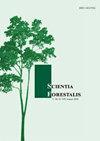Azadirachta indica y Jatropha curcas reducen el ataque de Hypsipyla grandella Zéller en Swietenia macrophylla King plantada en sistemas agroforestales
IF 0.4
4区 农林科学
Q4 FORESTRY
引用次数: 0
Abstract
S. macrophylla is an important forest species with economic value, however its main problem is its ecological vulnerability to the attack of H. grandella . In this sense, the objective in this study was to determine the effect of A. indica and J. curcas in reducing the attack of H. grandella on S. macrophylla plants planted in agroforestry systems. For this, the basal diameter (mm), height of plant (cm), attacked plants (%), attacked stems (%), apices attacked (%), leaves attacked (%), survival and mortality of larvae were evaluated (%). The lowest percentage of attack of H. grandella in S. macrophylla plants was registered in the association S. macrophylla with T. cacao and A. indica and also in S. macrophylla with T. cacao and J. curcas , planted at 1 m x 3 m, with 0.95 and 2.85%, respectively. However, the greater survival and mortality of larvae of H. grandella was registered in the association S. macrophylla with T. cacao and in S. macrophylla with T. cacao and J. curcas with 90.20 and 88.89% respectively. Thus, the use of A. indica and J. curcas significantly promote the reduction of H. grandella attack on S. macrophylla plants planted in agroforestry systems.印楝(Azadirachta indica)和麻疯树(Jatropha curcas)减少了农林复合系统中种植的大叶Swietenia macrophylla King对大叶Hypsipyla grandella zeller的攻击
大叶杉是一种重要的具有经济价值的森林树种,但其主要问题是对大叶杉的生态脆弱性。从这个意义上说,本研究的目的是确定籼稻和麻瓜在减少农林业系统中种植的大叶松对大叶松的攻击中的作用。测定了幼虫的基径(mm)、株高(cm)、侵染株(%)、侵染茎(%)、侵染根尖(%)、侵染叶(%)、存活率和死亡率(%)。大叶蝉侵染率最低的是大叶蝉与可可和籼稻的组合,以及大叶蝉与可可和麻瓜的组合(1 m × 3 m),分别为0.95和2.85%。而大叶蚜与可可、与可可和麻瓜的幼虫存活率和死亡率分别为90.20%和88.89%,大叶蚜与可可和麻瓜的幼虫存活率和死亡率最高。综上所述,在农林业系统中,使用籼稻和麻疯树可显著减少大叶蚜对大叶蚜的侵害。
本文章由计算机程序翻译,如有差异,请以英文原文为准。
求助全文
约1分钟内获得全文
求助全文
来源期刊

Scientia Forestalis
Agricultural and Biological Sciences-Forestry
CiteScore
1.00
自引率
0.00%
发文量
39
期刊介绍:
Scientia Forestalis is a scientific publication of the IPEF – Institute of Forest Research and Studies, founded in 1968, as a nonprofit institution, in agreement with the LCF – Department of Forest Sciences of the ESALQ – Luiz de Queiroz College of Agriculture of the USP – São Paulo University. Scientia Forestalis, affiliated to the ABEC – Brazilian Association of Scientific Publishers, publishes four issues per year of original papers related to the several fields of the Forest Sciences.
The Editorial Board is composed by the Editor, the Scientific Editors (evaluating the manuscript), and the Associated Editors (helping on the decision of acceptation or not of the manuscript, analyzed by the Peer-Reviewers.
 求助内容:
求助内容: 应助结果提醒方式:
应助结果提醒方式:


